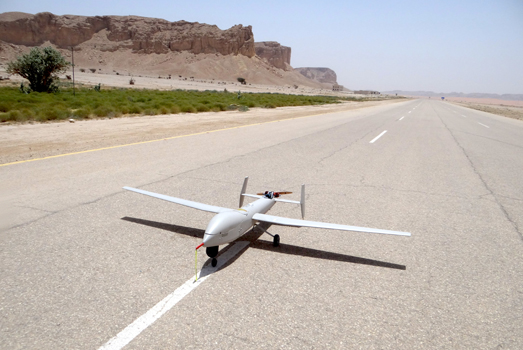KACST drones participate in research projects at KAUST

The Saker 4 drone is used in the joint KAUST/KACST projects.- photo courtesy of Mohammed Algarni
King Abdulaziz City for Science and Technology (KACST) and King Abdullah University of Science and Technology (KAUST) have joined efforts in developing autonomous sensing systems under the supervision of Prof. Khaled Abdullah Alhussan, director of the Space and Aeronautics Research Institute at KACST. The current focus is on two research projects of mutual interest. The objective of the first project is to prototype an unmanned-aerial-vehicle (UAV) based flash flood monitoring and forecasting system. While the second project is aimed at augmenting UAV navigation systems with vision to improve take-off and landing performance through data fusion.
The flash flood sensing project is developed jointly by Profs. Shamim and Claudel. It's a swarm of UAVs equipped with disposable Lagrangian microsensors used to sense the flooding conditions in real time. The UAVs drop these microsensors on demand and track their locations and speeds, indirectly monitoring the flooding conditions. The resulting data is sent in real time to backend servers for processing the data, and to generate real time flash flood estimates and forecasts. The set of UAVs would only be launched whenever flooding could occur, based on rain forecasts over the region, or based on other direct measurements such as electronic rain gauges.

Runway vision detection - photo courtesy of Mohammed Algarni
The second project KACST and KAUST are woking on is developed jointly by Profs. Sundaramoorthi and Claudel. It involves UAV inertial navigation systems that are augmented with vision systems. The vision helps to improve the performance of the UAV during the critical takeoff and landing phases, in which the uncertainty associated with the navigation systems (for instance, the GPS, gyroscopes, accelerometers) play a major role. The key of this project is a new computer vision algorithm. It is capable of detecting and recognizing the runway, and fuses this information with the onboard sensor feeds to improve positioning and attitude data.
Prof. Alhussan says KACST has produced 3 types of drones called Saker 2, Saker 3 and Saker 4. These aircrafts were managed by 200 engineers and technicians at National Center for Aeronautical Technology at KACST. These UAVs have a wide range of capabilities, which are particularly suitable for scientific research applications, remote sensing, monitoring oil and gas pipeline, border surveillance and traffic monitoring during day and night, agriculture, mineral exploration, and support relief operations.
 Microsensors test in Riyadh - photo courtesy of Mohammed Algarni
Microsensors test in Riyadh - photo courtesy of Mohammed Algarni
Saker 2 is a medium-sized UAV with a range of 150 km and can be developed to reach 250 km. It has an endurance of 8 hours, payload of 50 kg, a top speed of 120 kph and at a maximal altitude of 5,000 meters. The design of Saker 2 proved its quality in respect to stability and control through scientific and practical tests. The product is also of low cost through research and development. Saker 3 is a short range aircraft made of carbon fiber. It is among the lightest UAVs in its class as it weighs only 4.5 kg including sensors, onboard computers and landing gear. This UAV can take off from unimproved runways or be hand-launched. It can hover at a height of 1,000 meters and its flying range is 50 kms. Its performance can be improved by changing the current engine or the battery or by changing both. Saker 4, which was exhibited at Riyadh Fair in 2011, is the plane used in the joint KAUST/KACST projects. it has a 3.75m wingspan, and weights 25 kg in take-off configuration. This UAV has a payload capability of 5 kg and an endurance of 5 to 6 hours. It can fly at a maximum speed of 120 kph at an altitude of 5,000 meters. These aircrafts are made of fiberglass and carbon fiber, which has features like high ratio of strength over weight and enhanced durability.
This partnership between KACST and KAUST addresses the importance of scientific collaboration in this field to serve Saudi needs of drones as well as to build new generations of qualified scientists and engineers that are capable of the development of autonomous vehicles technology in Saudi Arabia.
Mohammed Abdullah Algarni
Academic Researcher at National Center for Aeronautical Technology, KACST

